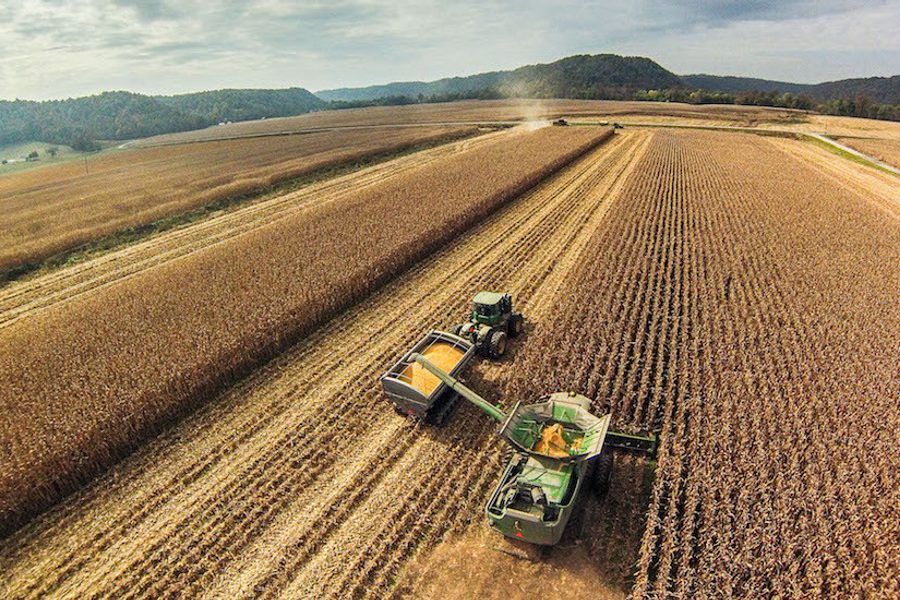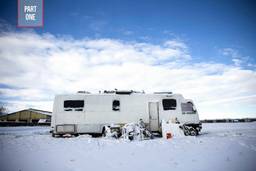Solving the 10,000-Year-Old Problem of Agriculture: An Interview with Wes Jackson
Allen White

Modern industrial-scale agriculture has proven incompatible with the structure and function of natural systems. To reverse the abusive practices that are undermining the long-term health of the land, humans, and non-human species, a new agricultural paradigm that mimics rather than contradicts ecological principles is urgently needed. In this interview, I explore the nature and prospects of such a paradigm shift with Wes Jackson, founder of The Land Institute and a leader in advancing research in and public understanding of ecological agriculture.
Allen White: For almost four decades, you have been a leading proponent of transforming the dominant agricultural system based on annual monoculture to one based on ecological principles. What inspired your belief in the need for this fundamental change?
Wes Jackson: In 1977, soon after The Land Institute was founded, I read a U.S. General Accounting Office (GAO) report about effective use of federal funds for soil and water conservation. Looking at some of the numbers, I noticed that soil erosion was then as bad as it was when the Soil Conservation Service (SCS) was formed in the 1930s. How could that be? The SCS had built thousands of miles of terraces and grass waterways. The organization had a great esprit de corps — with a team ranging from stenographers to PhDs, all dedicated to the common task of soil and water conservation. It was a nationwide effort. In Kansas alone, each of our 105 counties has a conservation district.
Shortly after reading the report, I took my students on a field trip to the Konza, a never-plowed native prairie in northeastern Kansas. There was no apparent soil erosion beyond natural replacement levels, no fossil fuel dependency or chemical contamination, no dependency on commercial fertilizer.
Those two experiences in short order — the GAO study and the field trip — set me on a journey to understand more completely the history of Earth abuse through agriculture. I had read a few seminal works, but decided to dig in a bit more and came to appreciate that soil erosion is a persistent, millennia-old problem.
AW: What accounted for this dramatic difference between native and farmed prairie?
WJ: Nature’s prairie is about the opposite of the vast acreage of such annual monocultures as corn, sorghum, sunflowers and soybeans, which usually feature soil erosion along with, in industrial times, the use of fossil fuels for traction and commercial chemicals. Nature’s prairie features perennials grown in mixtures. There is no plowing (and, therefore, little to no soil erosion), no planting every year, no fossil fuels necessary for growth, no chemical fertilizers, no insecticides, no herbicides — all of which are deemed necessary for grain monocultures.
AW: You have spoken of agriculture as the “10,000-year-old problem.” What do you mean by this?
WJ: As the ice retreated some 10,000 years ago in the eastern Mediterranean, agriculture began — first with wheat, an annual. Later, rice, another annual, was domesticated in the Orient, and still later, corn, an annual, in Mexico. These three grains are the world’s top three crops. Today, some 70 percent of our calories come from these and other grains grown on about 70 percent of our acreage, both domestically and globally. Reflecting on nature’s perennial polyculture of the American prairie, I wondered whether we could, through breeding, develop an agriculture based on perennial grains and, through the application of ecological knowledge, grow them in mixtures. Could such an arrangement grant us the efficiencies inherent within the natural integrities of a prairie ecosystem? In other words, could those processes, so prevalent in nature’s ecosystems, be brought to the farm? If so, we might be able to solve the 10,000-year-old problem of agriculture rather than relentlessly pecking away at problems in agriculture associated with annuals.
In 1978, I wrote an essay for the Friends of the Earth publication Not Man Apart on the history of Earth abuse due to agriculture. I suggested building an agricultural system based on the way the prairie works, though acknowledging that it might take fifty to a hundred years. To achieve this, I advocated a twofold effort: (1) crossing current high-yielding grain crops with their wild perennial relatives and (2) domesticating promising wild herbaceous perennial species.
AW: And this approach lies at core of The Land Institute’s mission?
WJ: Yes. In the early years, many viewed such a proposal as impossible. Now, nearly four decades later, with results in our fields and published papers, we are beginning to see the fruits of our persistence. We have attracted additional intellectual and financial support, and there is increased reason to be optimistic now, with the growing belief that soil erosion, fossil fuel dependency and chemical contamination can end in the foreseeable future. We move with confidence, knowing not only that natural ecosystems generally have greater net primary production than the human-managed systems that replace them, but also that they sequester carbon. Ecosystems are our elders, our best teachers, having evolved over millions of years. The ancient dualism between agriculture and nature can come to an end.
Our work is getting attention, enough so that I think at times it now has a life of its own. Financial support has now made possible an annual budget of about $5.4 million. Through an additional funding source (The Malone Family Land Preservation Foundation), we support fourteen graduate students and postdoctoral fellows at colleges and universities around the country. Some are domesticating wild perennials, some are crossing wild perennials with annual grains, some are doing ecological studies including soil biology, and still others are involved in a global inventory of promising wild candidates to domesticate and produce grain.
Three of our staff scientists have answered an old question: Why did our ancestors not develop perennial grains? The answer lies in what geneticists call “genetic load” or “mutation load,” which is not as much of a problem for annuals since they self-fertilize and can quickly purge their lethal mutants and fix a trait desirable to humans, such as resistance to seed shatter. Perennials, on the other hand, are primarily out-crossers, and because they tend not to accept their own pollen, their mutation load accumulates. We now know how to purge that genetic load thanks to current knowledge of molecular genetics and our modern computational power.
I would rather not use computer language as a metaphor for biological processes, but if we allow the word “hardware” to stand for any annual or perennial grain, then the perennial represents new “hardware” for agriculture. With new hardware comes new software potential. Where does it come from? Well, largely out of that broad discipline of ecology and evolutionary biology. When ecology is stuck with annual hardware, its utility is limited because of the presence of annual disturbances. But now the gap between ecologists and agriculturalists can be more completely closed. Agriculturalists, driven by the need to feed the world’s citizens, have had the burden of being prescriptive for ten millennia. Ecologists, by contrast, over the last 150 years or so, have had the luxury of being descriptive. Their job has been, like basic science generally, to understand how the world is or works — in this case, to study ecosystems.
This is a great moment in history, this merging of these two disciplines made possible with the new hardware. In my view, it represents the most essential merger in recorded history. Of course, this required “standing on the shoulders” of countless others over the millennia.
AW: How do genetically modified organisms (GMOs) fit into this new paradigm?
WJ: GMO work is best characterized not as a recent innovation, but as an extension of human cleverness, tracing back to the reductionist period of Bacon and Descartes in the early seventeenth century. In recent times, it has become part of the “smart resource management” approach to the world. It is more or less irrelevant to our work since perennialism, by contrast, is a way of life, not the result of a single gene. The GMO era, in that respect, has been a kind of distraction. What if we had devoted a comparable amount of time and money to achieving an adequate food supply by looking to nature as a standard or measure? Right now, agriculture is the number one threat to wild biodiversity, and land use is number two as a source of greenhouse gases.
GMOs do not represent a paradigm shift. Nor does our work in the greenhouse and field where, with every selection cycle, we are simply changing gene frequencies as has been the case for ten millennia. In such a manner, our populations are being genetically modified.
AW: In China, India and other developing countries, farms are generally small in scale. How applicable is the polycultural/perennial approach to small-scale cultivation?
WJ: Perennial grain polycultures can bring benefits at any scale. I imagine a time, independent of farm size, where perennial mixtures produce perennial grains. They will be, as now, primarily grass seeds, legume seeds, maybe sunflower seeds, and a few others. But they will be grown together at whatever scale, providing chemical diversification for the land. Diversity lowers the risk of a field-wide epidemic leading to a crash because overcoming the resilience that such diversity affords requires a tremendous enzyme system on the part of either insect or pathogen species. Beyond that, there are the integrated efficiencies, such as biological nitrogen fixation, tight nutrient cycling, and so forth. Polycultures are not new. They have been used in annual grain systems on scales large and small for millennia.
AW: You have often referred to the entrenched interests that stand in the way of progress toward a more ecologically harmonious and less abusive form of agriculture. What are these interests, and how can we reverse the damage they are causing?
WJ: I am not very good at devising strategies to end the power of destructive interests. I do think we have to start with a basic understanding of the history of life on Earth. All organisms are carbon-based; the best evidence holds that life started about 3.4 billion years ago. So, from the beginning, organisms have gone after energy-rich carbon. Plants fix atmospheric carbon, and animals eat. So far as we know, no species has ever practiced restraint in the pursuit of energy-rich carbon. Squirrels and ants store food for the winter, and we store grain and other foods for short periods. We use energy-rich carbon to power our societies. So powerful is this ancient imperative that even small efforts to put a cap on fossil carbon are met with fierce resistance by both sellers and users.
Now and then, we get exercised about the social justice problem — some more so than others. But as serious as that problem is, there is a larger problem: we are all dependent on economic growth. A cap on carbon seems essential if we are to stop the abusive practices associated with relentless economic growth. It seems easier to oppose social justice than to acknowledge limits, and here, once again, we encounter the 3.4-billion-year-old imperative. I suspect that fully living within our finite ecosphere into the foreseeable future is or will be the most formidable challenge our species ever has or will ever face. Social justice is certainly important, but it is not enough.
AW: People today are geographically and psychologically detached from their food sources. How great of an obstacle is this to mobilizing for change?
WJ: The disconnect is serious. I grew up on a farm in the Kansas River Valley, near Topeka. We grew most of our own food, some twenty-seven crops in all in the 1930s. We butchered our own animals — cows, hogs, chickens, turkeys. We cleaned up our plates. Nearly all farmers know that soil erosion represents the destruction of much of the foundation of food production. But then comes the highly dense carbon era. Labor was replaced by capital combined with highly dense carbon. In industrial societies, that era of shared values and common work is mostly gone. The lack of a sufficiently large constituency of people who feel the connection to the creatures and soil that sustain us makes change hard. The industrial mind has its way, which makes it hard to head off the confinement of animals in warehouses.
Aldo Leopold, the great ecologist and author of A Sand County Almanac, once said that there are two spiritual dangers from not owning (or, he could have said, living on) a farm. One is the belief that heat comes from the stove, and the other is the belief that food comes from a grocery store. Away from these real sources, one can find it easy to dismiss the idea of limits. Awareness of ecological fundamentals is critical for everyone, not just farmers. Much less than a century ago, the agrarian world was familiar to, and valued by, all. Once we developed institutions and practices that were almost totally dependent upon the imperative of fossil carbon, people became disassociated from the land and the creaturely world that sustain us. We need more people on the land. I am not talking about mere nostalgia now, but a practical necessity.
AW: The Great Transition uses scenarios to structure thinking about a plausible, desirable future. What is the best-case scenario for fifty years hence?
WJ: Long before 2070, the agricultural paradigm on which we are at work here at The Land Institute and increasingly elsewhere — now on five continents — will have enough of a life of its own to sustain itself. Some might say it does so now. By then, widespread perennial grain polyculture will have demonstrated that soil erosion will one day be a major problem of the past. Fossil fuel dependence will have shrunk to near zero, as will dependence on harmful chemicals. The native prairies and forests will have increasingly become the standard against which we judge our agricultural practices. Agriculture based on nature’s principles is about more than food security. My late friend Chuck Washburn, a metallurgist, once said to me, “If we don’t get sustainability in agriculture first, it’s not going to happen.”
Agriculture ultimately has the discipline of ecology and evolutionary biology behind it. Materials-based sectors have no such discipline. So I envision a future wherein food being produced by a resilient system that mimics nature’s economy serves as a model for society in general.
The transformed agricultural system we have in mind in our work would be information- rather than energy-intensive. A study of natural ecological systems should enhance our ability to imagine expanded possibilities for a future in which people, land, and communities interact as one to create shared prosperity, rather than compete in ways that undermine the well-being of the whole.
To ask agriculture to point the way forward for cultural and economic transformation seems like such a tall order that it receives little attention. But as we solve the 10,000-year-old problem of agriculture, our imaginations are sure to soar, for adequate solutions will be mimicking nature’s ancient economies. Agriculture may be the best place to begin, given that land use is the number two source of greenhouse gases, behind power plants and ahead of all transportation. The biggest component of agriculture is grain production. So if we draw attention to saving our soils and use the advancement of knowledge out of ecology and evolutionary biology, perhaps we can begin to get a grip on what we must know and do to shift toward a truly ecological paradigm. By 2070, I believe such a shift can be regarded as the way to go. Any industrial agriculture still with us will simply be on the wrong side of history.
I keep coming back to the 3.4-billion-year-old imperative. Before the fossil carbon era, we ran directly on sunlight with biological information for collection and dispersal. I think there is a general law: highly dense energy destroys information, both cultural and biological. Use of fossil carbon has allowed us to wage a war against the food landscape, the rainforest, and biodiversity wherever we can. The consequence of that biota loss has been a dangerous simplification, a loss of information, both cultural and biological. We call for public policy. But, as I see it, public policy is more of a derivative than a cause. Whether we can accelerate positive change fast enough to respond effectively as we head toward a population of 9 billion remains an open question.
AW: What are your aspirations for The Land Institute in this scenario?
WJ: Gary Snyder’s poem “For the Children” at the end of Turtle Island talks about how the hills of statistics go up, up, up, even as we all go down. He concludes, “In the next century or the one beyond that, they say, are valleys, pastures, we can meet there in peace if we make it. To climb these coming crests one word to you, to you and your children: stay together, learn the flowers, go light.” So, what are my aspirations? The Land Institute is contributing to those hills of statistics in that we are using tractors, farm equipment, combines, labs, and much more. It seems that we are going in the wrong direction along with everyone else. Our material- and energy-consuming research requirements have forced me to wonder, will the new varieties and new species we bring into existence be dependent on the technological array that brought them to the farm? My answer is “no.” Their creatureliness will still be there and available for the most primitive farmers of our agricultural history. The industrial world can’t so confidently say that about its renewable technologies: wind machines, solar collectors, and the like.
This all underscores the necessity to find analogs in nature to help our descendants on their journey to a more creaturely life, as the extractive economy fades into the past. Should that journey on the material side to create more efficiency and renewables be slow, we will at least have a better chance of keeping ourselves fed on the other side of the hills of statistics. Is that a “large enough aspiration”? Well, it is a start. A shift in collective consciousness must include the end of population growth (even contraction) if we are to take seriously the necessity of ecospheric healing.
All of this will require different ways of thinking about science. Artists will come front and center in the minds of scientists, not for nicety, but for the practical necessity of helping us all expand our imagination as we expand our collective consciousness.
If we can grant priority to the ecosphere as our creator and our protector, we will also want to look downward in the hierarchy of the sciences to ecosystems, to organisms, organs, tissues, cells, molecules, and atoms. We will want a new synthesis, a new understanding of our place in the world. Doing so, we will want to ponder the twelve laws of integrative levels (first articulated by James Feibleman in 1954). Reading and studying these laws will serve as “finger exercises” to assist the mind as finger exercises limber up the fingers of the pianist. In my view, the current field of environmental studies falls short of truly integrated, inclusive thinking. Perhaps ecosphere thinking can be more fulfilling. At any rate, we need a fundamental reconstruction in our thoughts.
AW: Who do you see as your key allies — present and future — in driving this transformation, e.g., environmental organizations, anti-poverty advocates, civil society at large, an awakened citizenry?
WJ: In one sense, there is no “them” or “us.” We are all in this together. In another sense, some have and will join the struggle, others not. Once a person has joined the struggle, so to speak, then let that person follow his or her passion. This makes us colleagues. None of us will know how our paths will converge on this journey. I don’t expect every agricultural researcher to want to work on herbaceous perennial seed-producing polycultures. We have always taken a long time horizon in our work. If here-and-now agriculturalists want to work on improving the software for the annual hardware, go ahead. Such research is needed.
The point is, we do need a shared vision built on ecology, which is nature’s economy, if we are to replace the industrial mind whose primary features are consumerism, accumulation, and extraction. The ecosphere has, to date, been more beautiful than useful. To expand the ratio to increasingly favor the beauty side will require healing.

Wes Jackson, founder and president of The Land Institute, is a leading researcher, educator, and proponent of ecologically-based agriculture. He is the author of several books, including New Roots for Agriculture, Becoming Native to This Place, Consulting the Genius of the Place, and most recently Nature as Measure. (Photo: landinstitute.org)
Nature’s Way: A Path to Ecological Agriculture was first published on greattransition.org and is posted on Rural America In These Times with permission from the organization and author.





